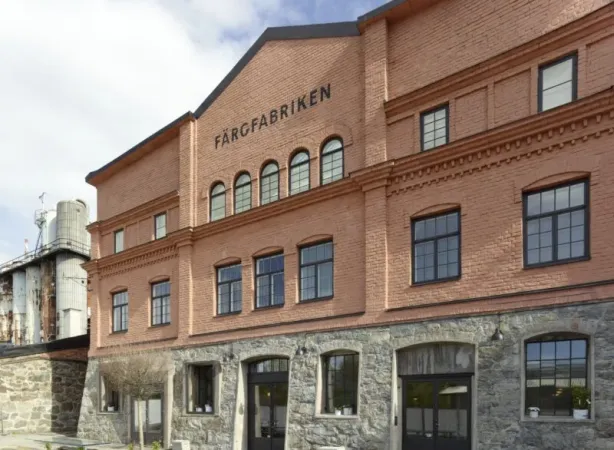Färgfabriken

Geographical area: Europe
Location: Stockholm, Sweden
City size: Medium (between 250,000 and 1,000,000 inhabitants)
Promoter: Lindéngruppen
Developer: Lindéngruppen and Färgfabriken Foundation
Start year:
End-year:
Implementation phase: Completed
Project size: Building
Total area of intervention (in sqm): 1.400
Total investments (in USD): -
The Färgfabriken is an art exhibition center located in the Lövholmen neighborhood on the western side of Stockholm. The renovation project took place on a former industrial building which hosted a painting factory owned by Beckers Group. The company was later acquired by the industrial development company Lindéngruppen, which currently owns the building site. The renovation project started in 1995 when the Municipality of Stockholm declared the protection of the building for its cultural and industrial heritage. Being prevented from demolishing the site given the shrinkage of paint production, the company actively engaged with artists, designers and architects to refurbish the building and convert it into an exhibition and art center. To do so, the Lindéngruppen financed the Färgfabriken Foundation to develop the refurbishment, manage the activities in the building and run the operational activities. The foundation has been established in 1995 by the Swedish Architect’s Association and two companies of the Lindéngruppen, and in the same year the first exhibition has been held in the center. The Foundation runs the operational and management activities in the buildings with financing provided by local, national and international authorities and entities. The first important renovation work, conducted by Skanska AB, focused on renovating the entire roof, re-opening the water system, levelling the entire pavement and implementing the heating and cooling systems. After the initial renovation, the building has been subject to several restoration works to improve the structure, which ultimately concluded in 2011. Given the company’s connection and interest in local artists and architects, the renovation of the building aimed to provide the local community with a center hosting cultural event, art exhibitions, seminars, workshops and other activities to engage with residents. The objective of the intervention was to reopen the underused space to serve the community with cultural and educational activities. In fact, as an industrial area the neighborhood saw the proliferation of illegal activities after working hours. Färgfabriken engages directly with the local community, architects, urban planners and other experts to discuss neighborhood challenges and promote urban transformation initiatives. The successful renovation of Färgfabriken sparked other successful renovations in the neighborhood, converting different former industrial buildings to host art studios and incubators for local small companies. After the Färgfabriken renovation, the Municipality of Stockholm continued investing to improve the entire surroundings, thus improving the streetlighting, constructing a new school and improving the transportation systems in the Lövholmen neighborhood. In addition, the Färgfabriken renovation created a community of local artists, designers and architects which found a lively market for their artistic creations.
Land use zoning
The entire building has been refurbished as a cultural space to host events, art and cultural exhibitions recreational activities, seminars and workshops. The building also provides a space for commercial activities, a bar and restaurant run by the Färgfabriken Foundation.
Economic
The successful renovation of the Färgfabriken project inspired the redevelopment of other buildings of surrounding industries. These buildings now host several incubators for small companies and different art studios, generating a positive effect on the local economy. In addition, the renovation of the Färgfabriken attracted a community of artists and designers which brought a positive economic effect for the local community. The project also benefits local designers and artists by providing them with a space for advertising and selling their products.
Environmental
The project did not envision any environmental effect, but it successfully renovated an existing and degrading building into an art and exhibition center. The project helped to save urban areas by employing an existing building instead of constructing new buildings for that purpose.
Social
Certificates
The renovation project did not receive any certification.
Funding source
The renovation of Färgfabriken has received private funding from the sponsorship of the owner Lindéngruppen and from the private entities financing activities and exhibitions. The former Lindéngruppen owner directly financed the renovation to convert the factory into a cultural venue. In addition, the project received public funding from the Municipal, Regional and National governments, local authorities and institutions, National public agencies and cultural institutions.
Financing and economic instruments
The renovation and the operational activities of the Färgfabriken Foundation are mainly financed by private resources of the owner Lindéngruppen. The group, which is the main sponsor of the renovation, provided around USD 310,000 to the Färgfabriken Foundation budget. The financing from the group supported both the renovation works and the management of the daily activities of the Foundation. The Foundation budget is also financed by several direct grants and funding provided by the Swedish Arts Council and the Culture Administration of Stockholm. The Municipality of Stockholm allocated around USD 81,000 and the Regional Government provided around USD 45,000. The National Government is also financing the Foundation and provided around USD 101,000, while the Ministry of Culture allocates around USD 87,000 every year for the Foundation activities. Part of the financing for the organization and sponsorship of cultural activities and exhibitions comes from a variety of public and private sources, such as the Stockholm Italian Institute of Culture, the Charles University, Gylleboverket, the Swedish Institute and other local and national entities. Lastly, the Foundation benefits from grants from the European Union by collaborating on EU-funded projects and participating in international networks and cooperative activities.